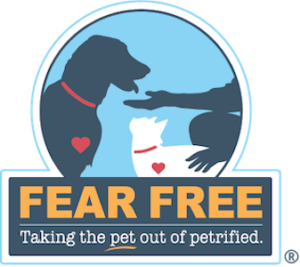By Christie Keith
When Dr. Laurie Peek showed up for her first shift providing care to animals living with people who were homeless, she didn’t have much in the way of resources beyond veterinary skills, her own two hands, and her Fear Free training. It turns out that was enough to make a huge difference for the pets and people she served.
A joint program of the University of Wisconsin’s veterinary medicine and social work schools, wisCARES provides vet care and social services to homeless people and their pets in the state’s Dane County. “We try to help people with housing instability become aware of resources that are available,” Dr. Peek says. “Many of them have fallen through the cracks, and their pets are a good way to reach them again, and provide the care they need to help them and their pets.”
Meeting challenges
She described the program as “very resource-limited,” which can make some Fear Free techniques challenging to implement. “Most of the medications and equipment are donated, so we don’t have access to a lot,” she says. “There’s no anesthesia at all, no treatment ward; it’s essentially just a couple of exam rooms with a check-in area and a pharmacy and a makeshift lab with a refrigerator to store vaccines. They don’t have the staff to give sedation or monitor the animals. There’s no end-of-life care and no controlled substances. It’s very bare bones.”
The animals who come into the clinic, she says, “are just like everyday general-practice patients, coming into an environment that probably has a lot of fear pheromones around. They’re in unfamiliar surroundings, with unfamiliar people. They’re picking up on fear, are nervous, are scared.”
Peek was seeing patients and clients she hadn’t ever seen before, so it wasn’t possible for her to give pre-visit medication. Nor could she give them anything once they arrived, as she had no pharmaceutical options. What she did have was awareness, empathy, and her knowledge of touch gradient, a technique she had learned during the Level One course.
Helping hand
Use of touch gradient means initiating and maintaining hands-on contact with the patient throughout the exam or procedure. It uses a gliding touch as the hands move to different parts of the pet’s body, from the least to the most invasive that will be required that day. This appears to reduce fear, anxiety, and stress (FAS) by eliminating surprise and creating some degree of predictability for the pet. It also helps the person doing the exam constantly assess the patient’s comfort level with the exam and procedures.
“The first time I tried it was with a small Chihuahua mix when we were doing an exam,” Peek says. “Usually we do the exams on the table, but the dog seemed to be more comfortable in the client’s lap, so I did the exam while they were holding the pet. When I came up closer, you could see the animal’s FAS was going up, as if he was saying, ‘I don’t know who you are! I don’t want you touching me!’”
Peek began gently petting the dog, and as he acclimated to her touch, she kept one hand on him. “If I’d removed my hand and put it back on, I’d have had to start over, and the fear would have started over, too,” she says. “He just relaxed into it and could predict what I was going to do. He could tolerate a little stronger touching as it happened slowly, as opposed to going right into strong handling.”
Next up was a pit bull mix, very active in the room, who needed an exam, vaccines, and a nail trim. “We didn’t put a muzzle on that dog,” she said. “I like to use the touch gradient with nail trims. Think about people, we get ticklish. And animals get ticklish and afraid, too, and always want to feel they can get away. With touch gradient, you’re not on top of them. You’re handling, petting, going down the back, to the leg, then trim a nail. If they continue to tolerate that, you can continue the nail trim. If they seem to want to get away, I let them, then start over with the touch gradient. I build trust.”
That day, she used touch gradient in nail trims, vaccines, and anal gland treatments. “It was a positive experience for the animals, and it also made the people more relaxed and less stressed in a situation that might be difficult for them,” she said.
Raising consciousness
“I just love how Fear Free raises the awareness of these animals’ state of mind, and the sensitivity we can show them even when we aren’t able to give them everything in the Fear Free toolbox. There’s still something we can do to help, and the first step is being aware of your patients’ FAS right from the get-go.”
Peek’s passion for touch gradient extends outside the exam room. “You can use this everywhere, not just in vet care,” she said. “In shelters, at home, when you trim your pet’s nails. It’s an awareness tool.
“Touch gradient is a connection to the animal so you can sense their fear, and know when they start to relax. You become connected to that animal, and instinctively temper what you’re doing based on how they’re reacting. You still do it, but in a way that’s respectful to them.”
This article was reviewed/edited by board-certified veterinary behaviorist Dr. Kenneth Martin and/or veterinary technician specialist in behavior Debbie Martin, LVT.




